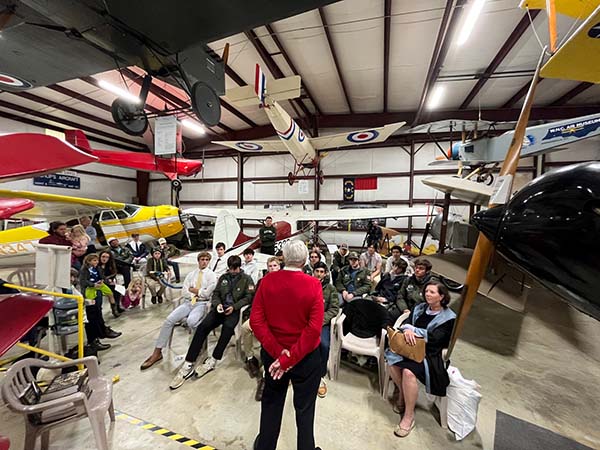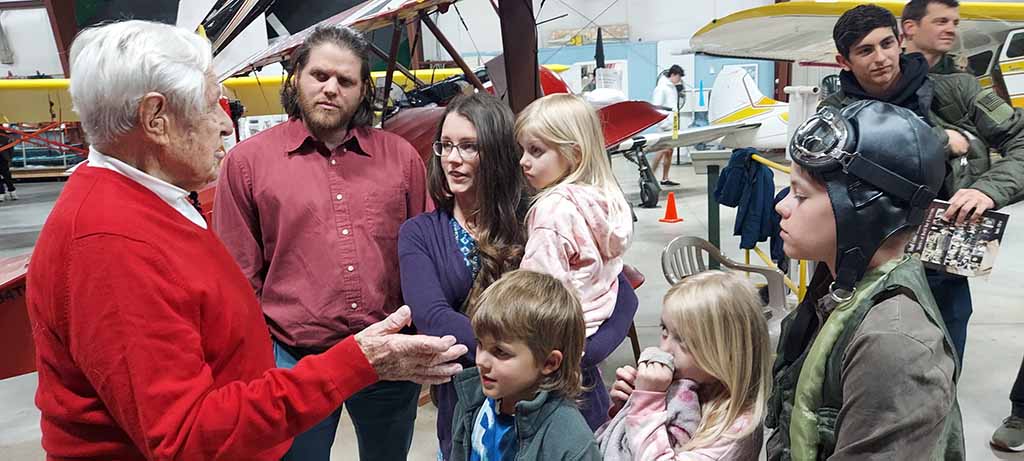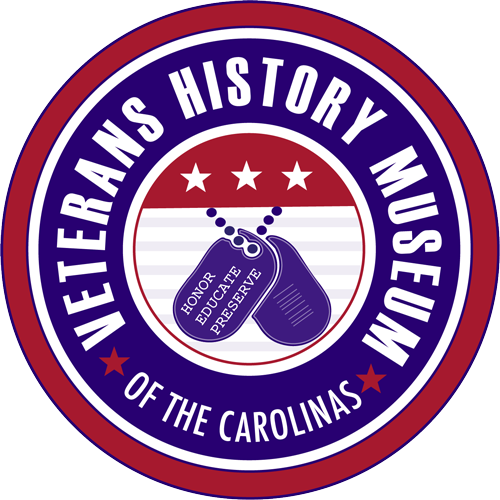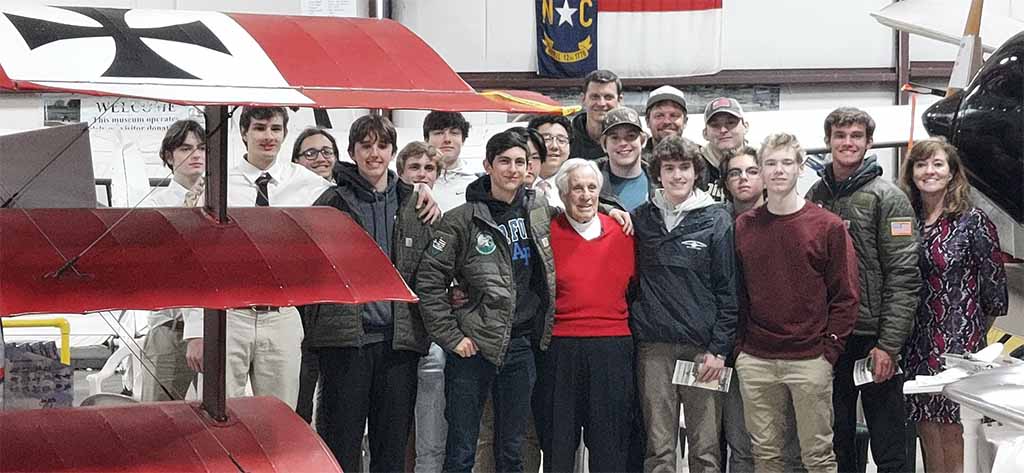WWII P-47 Pilot Ed Cottrell describes his harrowing experiences during the Battle of the Bulge.
Fifteen aviation students from Arden’s Christ School and their instructors listened intently as WWII P-47 Pilot Ed Cottrell described his harrowing experiences during the Battle of the Bulge. He told a spellbinding story of having a shot-up engine with two German Me-109s on his tail. Some of the students are in Christ School’s Robert Morgan ’36 Aviation Program and the others are members of the Veterans Service Club.
Standing among the nineteen airplanes hanging from the ceiling or parked on the shiny floor of Hendersonville’s Western North Carolina Air Museum, Cottrell, age 101, spoke to the 14- to 18-year-old high school boys. He told the story of encountering two German pilots up-close, as they flew right beside his damaged plane, gave him OK symbols with their fingers, and peeled off. “They let me live,” Ed said. “I’ll never know why.”

Ed Cottrell talking to Christ School students
Cottrell praised the P-47 for its toughness.
Appearing on behalf of the Veterans History Museum of the Carolinas, Cottrell spoke to the young flyers about how he chose to become a pilot in 1943. He selected the Army’s offer rather than the Navy’s because the Army gave him time to finish college before reporting for duty. Cottrell praised the P-47 for its toughness. His crew chief showed him 30-40 bullet holes from small arms fire after one of his 65 missions. He flew from a small makeshift runway in St. Tron, Belgium during the Battle of the Bulge.
Cottrell said that when his 18-cylinder engine was shot and the German Me-109s showed up, he barely made it back to his landing strip. The Pratt & Whitney engine got him home with only 10 cylinders working, only stopping when he was on final approach to land. He made a dead-stick landing. He told his audience, “I kissed the ground. I wouldn’t be here today if I hadn’t had that Pratt & Whitney engine.”
Western North Carolina Air Museum
The airplanes in the Western North Carolina Air Museum provided the perfect setting for this special event, surrounding the attendees and speaker with original planes or replicas in use from 1917 to 1948. Please visit westernnorthcarolinaairmuseum.com for more information.
Many of the high-school aviation students were ready with questions when Cottrell concluded his stories. Some examples: “Why did you like the P-47 so much?” “How did you decide to become a pilot?” “Was your encounter with the German pilots the closest you came to death?

Ed Cottrell with the Ballantyne Family
Christ School’s new aviation program was announced in 2022 as follows:
“The Robert Morgan ’36 Aviation Program will be offered during the Winter Sports season for up to 10 boys. The program is named after Christ School alumnus Robert Morgan, who graduated in 1936. Morgan famously flew the Memphis Belle in World War II. The school has procured a plane – an American Champion Citabria (7GCAA) – and has the luxury of two former Navy fighter pilots, Steven Hoffert and Les Thornbury, as instructors. Both men shared their vision for the Morgan Aviation Program: they want every student to take real, concrete steps toward FAA flight ratings, including a FAA Student Pilot Certificate, Full FAA Private Pilot Ground School, Official FAA Private Pilot Written Exam, and the opportunity for a FAA Class 3 Medical Certificate needed to fly solo. The program is now completing its first year.”
Nestled on 500 acres in the Blue Ridge Mountains in Asheville, North Carolina, Christ School is an Episcopal boarding school founded in 1900 with a full college preparatory curriculum for the more than 290 boys enrolled. Information about Christ School’s distinct programs in Athletics, World Languages, Travel opportunities, Outdoor Program, Service Learning, Choir, Broadcast Journalism and more visit: https://www.christschool.org/
After Lt. Col. Cottrell’s program on April 26, the students presented their new hero with a jacket from the Aviation Program. They lined up to meet him and ask for his signature in the book which tells his complete story. In addition to the students, Christ School chemistry instructor James Ballantyne brought his family to meet the WWII hero. The parents introduced their children, one of whom was dressed as a WWII pilot.
Two of the children presented drawings they had made to honor Cottrell. Their pictures included drawings of airplanes and messages. One read: “The Greatest Generation. Thank you for your service 2nd Lieutenant Edwin Cottrell! 48th Fighter Group 493rd Fighter Squadron.” The other drawing had “WWII” and “Thank you for your service” framing the child’s drawing of the airplane. These young home-schooled fans had obviously done their research to learn about Cottrell’s career before they met him.
Their mom, Jill Ballantyne, said, “They were all very excited to be able to hear a firsthand account of the war, and for the opportunity to honor this living legend in person.”
Ed Cottrell’s first-person telling of his part in liberating Europe from Nazi rule provides a view of history unlike anything found in a book. In addition to speaking to many groups about his stories, he serves as an Honorary Board Member of the Veterans History Museum of the Carolinas, located at 21 East Main Street in Brevard. Open hours are Tuesday—Saturday from 11:00 AM to 3:00 PM. Admission is free.
For more information or to schedule a group tour, please call 828-884-2141 or visit theveteransmuseum.org. To inquire about scheduling Ed Cottrell as a speaker, email mikemccarthy@comporium.net.
Top photo: Ed Cottrell (middle) with Christ School Students

